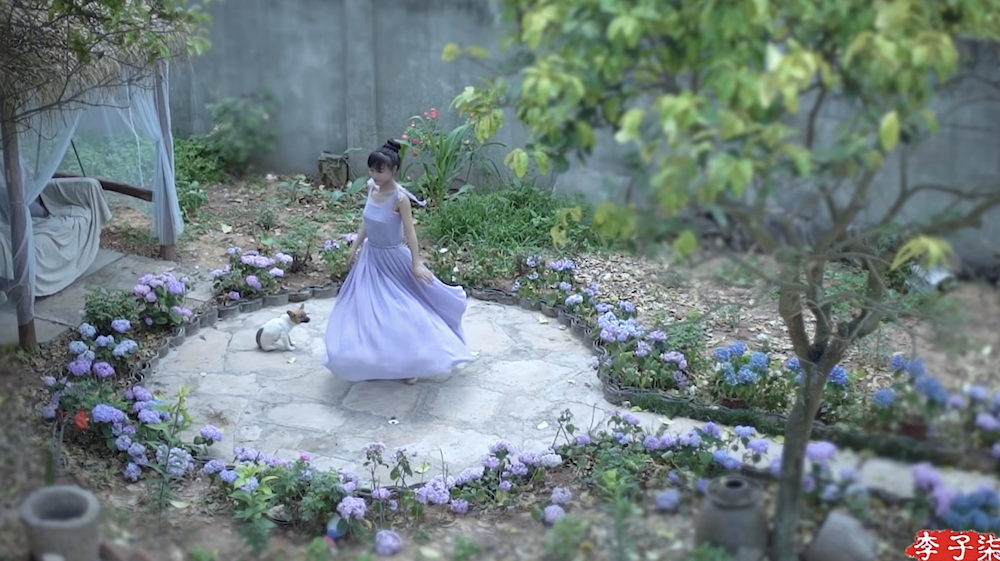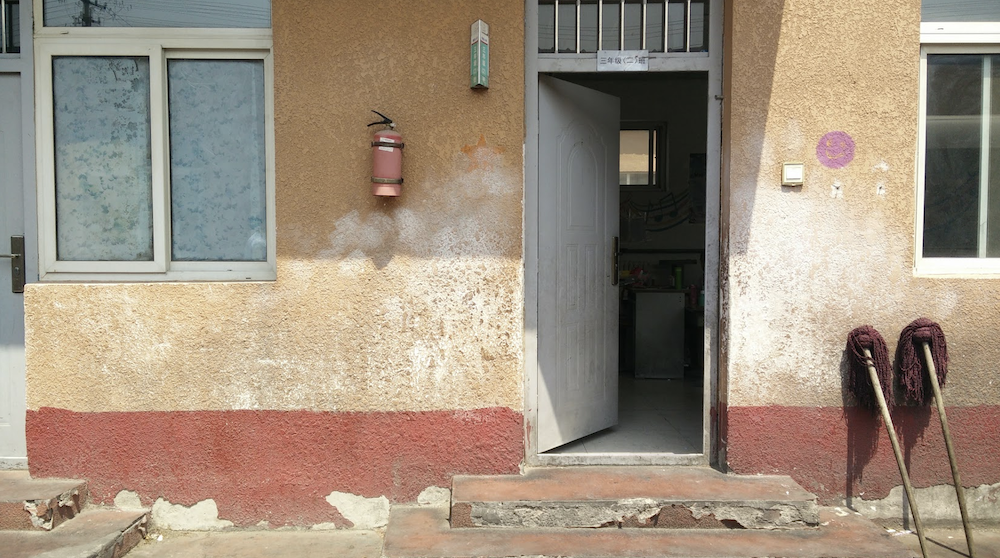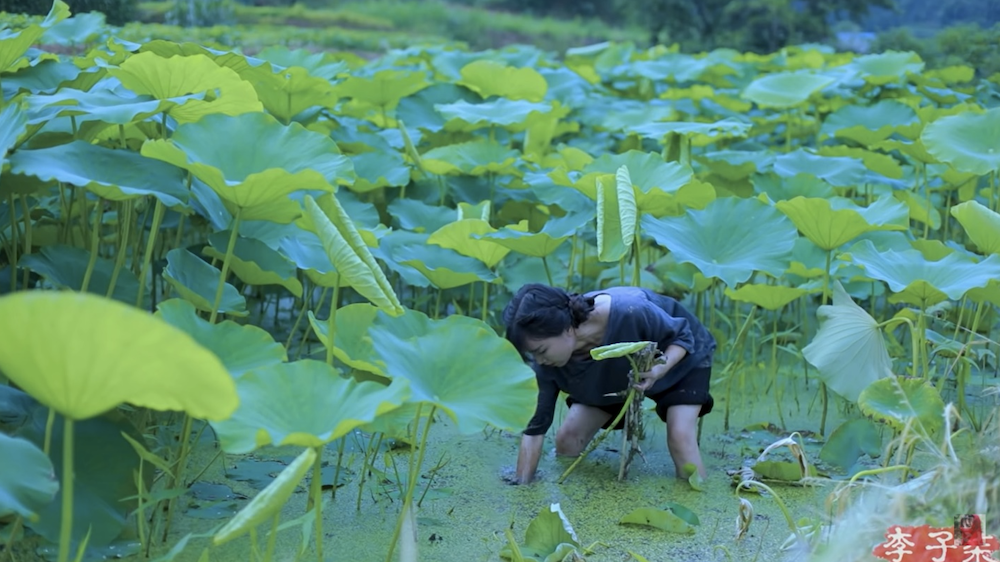Boasting several national honors from the Chinese Communist Party for preserving the “intangible cultural heritage” of China, millions of followers on her myriad social media accounts, and a really freaking cute flock of lambs, Li Ziqi holds us all in ASMR-induced trance. She’s the real triple threat — videographer, farmer, and DIYer — and we have her to thank for getting us through the days we just wanted to be comforted.
But honestly, I think her videos can speak for themselves.
Li Ziqi launched her YouTube channel in 2017. Since then it has accrued 2.4 billion views, landing her a Guinness World Record for the highest number of subscribers for a Chinese-language YouTube channel. Her most popular videos’ views number in the neighborhood of 30 million, many of which are from international servers. The imagery of Li’s videos recalls a different time, when farm labor was similarly glorified in China’s past. Scholars have categorized Li Ziqi videos as part of a soft power push; Li was most recently nominated to the All-China Youth Federation, commemorating her efforts to valorize an imaginary lifestyle that probably never existed for anyone in Chinese history.
It’s lowkey propaganda, but who cares when you just want to watch an immaculately dressed young woman pound the shit out of purple rice she harvested in front of her house? Particularly after two years of global trauma, it’s nice to escape into Li’s farm-to-table fantasy. The New York Times’s Tejal Rao even shouted her out as both “deeply soothing” and “like the main character in some kind of post-apocalyptic novel”; Fortune put her on their list of 25 pandemic creators and touted her “ASMR-adjacent steadiness.” Li Ziqi was made for the internet.
¤
Somewhere in rural Sichuan, set to the ambient soundtrack of instrumentalized Chinese folk songs — the YouTube equivalent of ethnic elevator music — Li Ziqi harvests huge yams, raises ducklings, steams fish heads, and fluffs raw silk. Her content reflects a broader trend in modern Chinese internet culture: fugu, or “retro culture.” The obvious Western analogue is the online trend of cottagecore, in which flower-crowned white women rent cabins in the Adirondacks and hike for 30 minutes before returning to their desk jobs in New Jersey. It’s like Thoreau’s Walden, but glampier: a chance to escape the pencil-pushing doldrums of professional life. Instagram accounts and YouTube channels abound, highlighting fields of flowers, dainty linen dresses, and steaming cups of floral tea. In the “slow living” aesthetic of Peter Rabbit and Benjamin Bunny, it really is nice to wear an apron over a dress with modest ruffles and walk around in your wellies while pulling carrots out of the ground. Or, if you can’t do it yourself, it's almost as nice — or even nicer — to live vicariously through a TikTok.
Li sits squarely in the purview of global social media influencing. Her videos feature a high level of production, showcasing time-lapse segments of delicate seedlings sprouting, calming traditional background music, and a hair and makeup team that doesn’t quit. Li’s characterization, too, is highly stylized: a pious granddaughter returns to the family farm to care for the ailing grandmother who raised her. Unlike American versions of cottagecore, though, Li Ziqi’s life is categorically not a vacation. It’s a type of peasantry, albeit romanticized, that feels passively voyeuristic.

The protagonists of Li’s videos are women: Li herself, bedecked in traditional dress, and her grandmother, often bundled up in a quilted jacket. According to the biography on her website, Li spends her days toiling on the farm to care for her grandmother, who raised her to be self-sufficient. Indeed, Li and her grandmother could edit Mao Zedong’s famous dictum “women hold up half the sky” to say that they hold up the whole sky instead; in Li’s videos, it certainly seems like the only work worth valorizing is women’s work. Despite the unglamorous nature of farm labor, Li’s producers style her as overtly femme: she wears spotless silk jackets with white fur-lined collars, as well as a full face of makeup. Even when Li is hauling baskets full of river clay, there isn’t a flyaway or muddy smudge in sight. The visual textures of Li’s appearance are both luxurious and feminine even if the work itself is hard.
To be clear, no one with significant financial resources would want to permanently roleplay the reality of rural peasantry in China. The half-remembered, georgic lifestyles of older generations are glamorized on YouTube, but the content purposely elides what comes with rural life in China’s past and present. The list of hardships, even with events confined to the past century, seems interminable in its violent intensity: starvation, sickness, forced migration, the violent conclusions of the civil war, upheaval due to land reform, the internal purge of rightists at all levels of government and society, large-scale labor camps, the germinating Cultural Revolution. The work of microhistorians to let the (European) peasant speak seems nearly impossible in this case, even though the CCP historically has had a laser-sharp rhetorical focus on representing peasantry: farmers are the leaders of society, and women are as well. But Li’s popular farmcore videos from 2017 to 2021 never reference the collective memory of the violence of the 20th century; it exists with no popular archive. Nan Z. Da has described this lack of testimony as political gaslighting, or “the invisibility, the constitutive muteness” of victims who are not “psychologically and physically intact.” Instead, Li Ziqi smooths the wrinkles out, harkening back to a nonexistent epoch when peasant labor meant succor and freedom.
¤
In 2017, the year Li Ziqi launched her YouTube channel, I was living and working in Beijing. I was teaching English at a migrant school for primary-school-age children on the outskirts of the city, so far from where I lived on the Third Ring Road that I took three subway lines and a hired van to get there, occasionally in inclement weather. Beaten by the bone-chilling wind sweeping into the valley from Inner Mongolia, Beijing winters are punishingly dry. Often by the end of class, the students and I would dust a film of blond sand off our coats, which we wore constantly in the unheated classroom. I didn’t know much about my students other than they were quick and eager to learn and please. Every week we’d sound out vowels and play games like What’s the Time Mr. Wolf. Sometimes we would read graphic novels and chant American nursery rhymes. When I left the classroom for the last time, they said in perfect unison, We’ll miss you, Huang laoshi! My students’ spirited personalities and positive attitudes belied long histories of poverty and exploitative labor practices.

Migrant labor has been a reality of Chinese history since the early 20th century. In China, residential permits are granted to people at birth, which allows Chinese nationals to access social services exclusively within their home province. But, forced to move to megacities to support themselves and their families, an estimated 286 million migrant workers give up their children’s rights to state-sponsored education, and take on the grueling triple burden of urban rent, unstable wage labor, and constant threat of displacement. My boss at the migrant charity would tell me stories of how teachers would show up at unsanctioned schools to find that they had been bulldozed to the ground and the surrounding migrant neighborhood empty of all its residents. They would never hear from their students again. Sometimes the state had to prove a point.
Most migrant laborers never get the opportunity of homecoming, like Li. They are simply too poor to afford working sustainably in their home provinces; they must risk squalid living conditions (the average living space is about 17 square meters per person) and unsafe work to survive. Often, migrant workers only return home for the Lunar New Year holiday and must go back to their adopted cities immediately, otherwise risking unemployment. Parts of Li’s life certainly smack of authenticity — she and her grandmother speak Sichuanese dialect, as opposed to the national dialect of Mandarin Chinese, and they live in some ambiguous corner of southwestern China’s countryside. But the form of social mobility that would allow a migrant family to return home and prosper is pure fantasy.
Truthfully, I don’t know who this fantasy of idealized homecoming is for. Is it for city dwellers around the world, who yearn for the romantic trappings of country life without having to actually live it? Or maybe it’s for my students and their families, in order to feel some kind of oblique pressure from the state to move back to their home provinces. Or is it for someone like me, a distant member of the Chinese diaspora who wants to visualize a fictional China in which my ancestors never resided? For international viewers, it’s one thing to dream about a Chinese past and present that both do not exist, from a faraway country whose tragedies of labor exploitation are largely swept under the rug. It’s another thing when the children of migrant worker families run into your arms after a particularly good lesson.
Questions of audience and reception do not seem to trouble Li at the moment. Curiously, she has not posted a new video to her YouTube channel in six months, though her Instagram account remains somewhat active and routinely publishes throwback reels. Supposedly mired in a legal dispute with her marketing agency, Li still has not reappeared consistently on social media, much to the disappointment of her international fans.
¤
So why watch these videos in the first place? Are they just universally appealing, insipid content that global audiences watch in order to self-soothe? Douyin, the Chinese version of TikTok, overflows with seconds-long videos of people doing different kinds of work (like building bamboo furniture or deep-frying shrimp crackers) outside the ordinary office job or dangerous menial labor (like street-sweeping or cleaning public toilets). It’s a way to imagine different types of production — how, indeed, are latex gloves made? How, indeed, to till a garden? And it’s vastly different from the time spent laboring for 12 hours at a computer. In China, there is a domestic incentive to make bite-sized escapist videos; these short-form videos are an easy way to cash out with gotcha content. It’s not unlike Western influencers making quick money on ads based in Instagram Reels: like many internet-based stimuli these days, it’s all just a shopping app. Nevertheless, Li’s domestic and international fans sing her praises and clamor for more: “[H]er knowledge [strives] to show us her heritage […] lots of love from a Greek viewer!” “As a student from Vietnam and currently studying in the US. Your videos are absolutely incredible and relaxable to me. They always remind me about my childhood a lot, and also my dream countryside life.” “Tus videos me transmiten calma, me relajan y me encanta ver [la] trabajadora que eres. Muy talentosa!” [Your videos calm me down and relax me, and I love seeing how hardworking you are. Very talented!]

It’s true that Li works hard — she clearly knows her way around a meat cleaver and can bale hay by hand — but her production team works harder. According to a televised interview in 2019, Li employs only one videographer and one assistant; she prefers to direct herself. (But who runs her online shop, and who runs her publicity team?) Li has her fair share of skeptics, so much so that she has released behind-the-scenes photographs of her setting up shots. For much of her fanbase, though, it doesn’t matter. One commenter said, “I don’t care if it’s ‘real’ or not. Because absolutely nobody can deny that you always worked hard!” Viewers, myself included, devour her content for several reasons: destressing, fetishizing farm life, and, perhaps most insidiously, learning about a false Chinese heritage. Li serenely mixes a propaganda cocktail of historical backfill, alternate present, and good old-fashioned nostalgia. And regardless of identity politics, we drink it up.
As both a migrant school teacher and an American student researcher in China, I experienced cultural whiplash on a weekly, if not daily, basis. Sometimes, I would get off work at the migrant school and make my way to the mansions of ambassadors in Beijing’s expat district or orchestra concerts in the Forbidden City. It is hard to imagine the business school millionaires or the manicured wives of diplomats ever wanting to live the miserable and backbreaking life of a migrant worker, even if they occasionally enjoy a Li Ziqi video to unwind after work. From an outsider’s perspective, I get the appeal of these videos — rural Sichuan is preternaturally beautiful, and aesthetic DIYing is a delight to watch. But having witnessed the hardships of migrant workers in person, I always notice how Li works to make the fiction of her videos attractive through amplified nostalgia and quiet spectacle, which obscure all evidence of the realities of migrant labor. Every so often, when I am seeking a moment of cottagecore-induced calm, I think of my students. And suddenly calmness eludes me.
Behind the superficial veneer of Li Ziqi’s beautiful handmade garments and bamboo furniture hides the world of Chinese migrant workers. By consuming Li’s oeuvre on social media, workers everywhere can maintain the phantom of agency over their work and quality of life, fully aware of the illusion they and others create to obfuscate an impoverished lifestyle, both rural and urban. For migrant laborers, it is a life of instability for themselves and their children.
This world is invisible on Li Ziqi’s YouTube channel. Autumn fog rolls over the mountains; puppies slumber under hand-sewn quilts. Li steams a fish. She builds an oven. She bakes bread.
¤
Stephanie Wong is a writer and doctoral candidate in History at Brown University.
¤
Featured image: "李子柒 2017" by 李子柒 Liziqi is licensed under CC BY 3.0. Image has been cropped.
LARB Contributor
LARB Staff Recommendations
On the Chinese Cultural Revolution: Thought Exercises for the 21st Century
LARB presents a conversation with four scholars on the Chinese Cultural Revolution: Lingchei Letty Chen, Nan Z. Da, Frank Dikötter, and Jie Li.
Bachelor Nation and the Ancient History of Gamifying Romance
LARB presents the second entry in “Pasts Imperfect,” a column that explores the impact of ancient pasts on the present.
Did you know LARB is a reader-supported nonprofit?
LARB publishes daily without a paywall as part of our mission to make rigorous, incisive, and engaging writing on every aspect of literature, culture, and the arts freely accessible to the public. Help us continue this work with your tax-deductible donation today!
:quality(75)/https%3A%2F%2Fdev.lareviewofbooks.org%2Fwp-content%2Fuploads%2F2022%2F02%2Fliziqi-1.png)